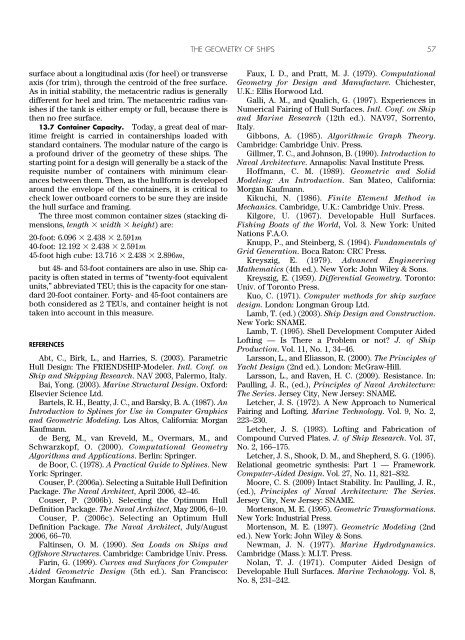The Geometry of Ships
You also want an ePaper? Increase the reach of your titles
YUMPU automatically turns print PDFs into web optimized ePapers that Google loves.
THE GEOMETRY OF SHIPS 55<br />
Fig. 41<br />
A sonar dome formed as an appendage to the original<br />
fair surface.<br />
dome, and does not have to worry about side effects on<br />
the remainder <strong>of</strong> the surface.<br />
A cavity such as a thruster tunnel (Fig. 26) is sometimes<br />
treated as a negative appendage. <strong>The</strong> net freeflooding<br />
volume <strong>of</strong> the tunnel is subtracted from the sum<br />
<strong>of</strong> displacement volumes <strong>of</strong> other (positive) appendages.<br />
12.5 Sailing Yacht Keels. A sailing yacht needs to<br />
generate hydrodynamic lift forces to resist the component<br />
<strong>of</strong> sail force that tends to push it sideways. It also<br />
needs roll stability to resist the heeling moments arising<br />
from sail forces. In monohull yachts, a keel appendage is<br />
the most common answer to both these needs. A keel is<br />
the repository for a substantial fraction <strong>of</strong> the yacht’s<br />
total “all-up” weight — more than 80 percent in extreme<br />
cases — and is shaped so as to carry this weight as low<br />
as possible, while providing an effective lifting shape <strong>of</strong><br />
sufficient lateral area, adequate streamlining, and low<br />
wetted surface. It must be stressed that the “lift” required<br />
for a sailboat to sail is a horizontal force component,<br />
not vertical as in an airplane. A sailing yacht can be<br />
viewed (to a degree) as an airplane flying on its side,<br />
with its two wings — keel on one side and sails on the<br />
other — having quite different shapes and proportions<br />
primarily because <strong>of</strong> the large difference in density (a<br />
factor <strong>of</strong> about 830) between the two fluids they operate<br />
in. (However, the analogy can only be taken so far; no<br />
airplane derives significant propulsive force from the difference<br />
in velocity at its right and left wings!)<br />
Section 13<br />
Arrangements and Capacity<br />
13.1 Cargo Capacity and Tonnage. A basic characteristic<br />
<strong>of</strong> any cargo ship is the quantity <strong>of</strong> cargo she is<br />
able to carry — her cargo capacity. Two fundamental aspects<br />
<strong>of</strong> capacity are<br />
• Volume: how much space is available for cargo<br />
stowage?<br />
• Mass or weight: how much load can she carry?<br />
<strong>The</strong>se characteristics are, <strong>of</strong> course, crucial to the<br />
ship’s commercial success.<br />
<strong>The</strong> gross deadweight <strong>of</strong> a ship is the difference<br />
between the full-load displacement (mass) and the<br />
light-ship mass, i.e., mass <strong>of</strong> hull steel, machinery, and<br />
outfit. <strong>The</strong> cargo deadweight is the result <strong>of</strong> deducting<br />
from gross deadweight the maximum values <strong>of</strong> variable<br />
masses <strong>of</strong> fuel, stores, fresh water, crew, and their<br />
effects.<br />
Registered tonnage is a volume measurement expressed<br />
in “register tons” <strong>of</strong> 2.885 cubic meters (100<br />
cubic ft.). <strong>The</strong> gross tonnage is the volume <strong>of</strong> all<br />
enclosed spaces <strong>of</strong> the hull and superstructure. Net<br />
tonnage is the gross measure, less deductions for nonrevenue-producing<br />
spaces such as machinery space<br />
and crew quarters. Net tonnage measurements are the<br />
basis for some important operating costs such as harbor<br />
dues, dockage fees, and canal tolls. Gross tonnage<br />
is used as the basis for drydocking charges, and applicability<br />
<strong>of</strong> various safety rules and regulations. Details<br />
<strong>of</strong> tonnage and its determination are discussed in<br />
Chapter 8 <strong>of</strong> Lamb (2003).<br />
13.2 Compartmentation and Subdivision. <strong>The</strong> interior<br />
space <strong>of</strong> a ship is subdivided into functional<br />
subspaces or compartments suited to the vessel’s mission<br />
and purpose. This is accomplished by partitions<br />
analogous to the floors, ceilings, and interior walls that<br />
subdivide a building into rooms. <strong>The</strong> partitions have<br />
structural requirements related to the loads they must<br />
support, and also are integrated into the general structure<br />
<strong>of</strong> the ship, providing critical stiffening and<br />
reinforcement for the hull shell, weather deck, and<br />
superstructure.<br />
Common classes <strong>of</strong> compartments are: cargo holds for<br />
dry cargoes, cargo tanks for liquid cargoes, water ballast<br />
tanks, machinery spaces, tanks for consumables, spaces<br />
for stacking containers, accommodation spaces for crew<br />
and passengers, and void spaces. Efficient layout <strong>of</strong> all



